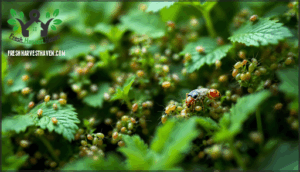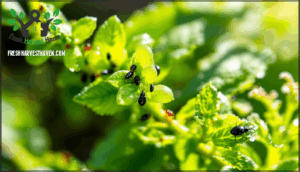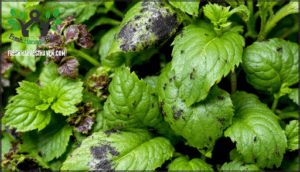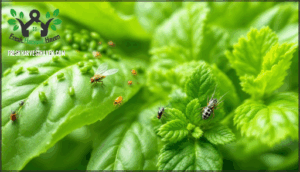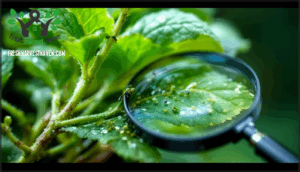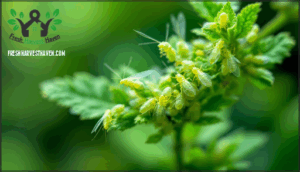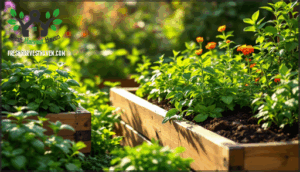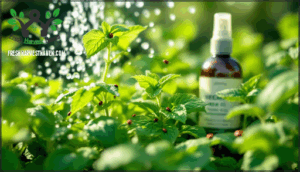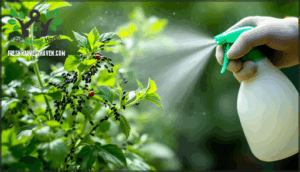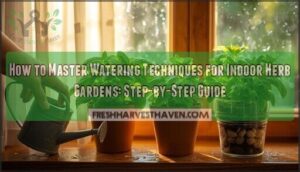This site is supported by our readers. We may earn a commission, at no cost to you, if you purchase through links.
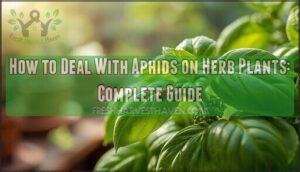
The good news is that dealing with aphids on herb plants doesn’t require harsh chemicals or complicated procedures. With the right combination of early detection, natural predators, and targeted treatments, you can reclaim your herbs and keep these persistent pests from returning.
Table Of Contents
Key Takeaways
- Aphids reproduce explosively through parthenogenesis, with a single female producing 40–80 offspring and populations capable of 10–30 generations per season, making early detection and consistent monitoring essential to prevent infestations from spiraling out of control.
- Natural predators like ladybugs and lacewings can reduce aphid populations by 60–80% when you create supportive habitats with flowering herbs, ground cover, and diverse plantings—turning your garden into a self-regulating pest control system.
- Soft-bodied aphids are vulnerable to simple physical and organic controls, with water sprays, insecticidal soap achieving 95% mortality, and neem oil disrupting reproduction by 88%, making harsh chemicals unnecessary for effective management.
- Prevention through regular inspection, companion planting with aromatic deterrents like garlic and marigolds, and maintaining plant vigor through proper watering and air circulation creates conditions that naturally discourage aphid establishment before treatment becomes necessary.
Identifying Aphids on Herb Plants
Aphids are one of the most common pests you’ll encounter on herb plants, and catching them early makes all the difference in protecting your garden. Before you can fight back, you need to know what you’re looking for—these tiny insects are masters at hiding, but they leave telltale signs once you know where to spot them.
Let’s walk through how to identify aphids on your herbs so you can take action fast.
Common Aphid Species on Herbs
Your herb garden can host five common aphid species, each with distinct characteristics. Green Peach Aphids infest over 500 plants, including basil and mint, appearing pale green to pinkish. Melon Aphids target dill and parsley with dark green to yellow coloring. Foxglove Aphids prefer lemon balm and sage, showing pale green bodies with dark patches. Cabbage Aphids display a waxy gray-green coating, while Potato Aphids are larger, reaching 4 mm in green, pink, or red.
These aphids are known to produce live young, furthering their rapid spread.
Recognizing Aphid Appearance and Colors
Once you know which aphid species you’re dealing with, spotting them becomes easier when you understand their basic body shape and color variations. Look for these key features during aphid identification:
- Pear-shaped bodies measuring 3-6 mm with soft, oval forms
- Aphid color variations from green and yellow to pink, red, black, or gray
- Winged aphid forms appearing when colonies grow overcrowded
- Cast skins left behind as nymphs mature through identifying nymph stages
- Sticky honeydew residue coating leaves below infestations
Adult aphids and aphid larvae cluster together on tender plant tissue, making detection straightforward once you recognize their characteristic shape.
Signs of Aphid Damage on Herb Plants
Beyond the insects themselves, your herbs will tell their own story of stress through a series of telltale symptoms that worsen as the infestation grows. Watch for these common signs of aphid damage:
| Symptom | What You’ll See |
|---|---|
| Stunted Herb Growth | New shoots stay small, plants stop developing normally |
| Leaf Curl Symptoms & Discolored Herb Leaves | Leaves twist downward, turn yellow or mottled |
| Honeydew on Herbs | Sticky coating attracts ants, develops black sooty mold |
| Herb Plant Wilting | Stems droop despite adequate watering, overall weakness |
These herb garden pests cause leaf damage through constant sap-feeding, which stresses plants and creates opportunities for secondary infections.
Distinguishing Aphids From Other Pests
While aphids share some traits with whiteflies, spider mites, and thrips, a few key differences will help you confirm what’s actually plaguing your basil or parsley. Here’s what sets aphids apart in pest identification:
- Whitefly Presence: These fly away when disturbed, unlike stationary aphids
- Mite Detection & Thrips Identification: Spider mites spin fine webs; thrips are more elongated and faster-moving
- Scale Insects & Leafminer Signs: Scales attach firmly as bumps; leafminers create tunnels inside leaves rather than feeding externally
Proper insect pest management starts with accurate aphid identification and habit observation among garden pests.
Inspecting Leaves, Stems, and Buds for Aphids
To catch aphids before they multiply out of control, you’ll need to get up close and inspect the spots where these pests love to cluster and feed. Focus on the underside of leaves, along stems near growth nodes, and around tender buds where aphids gather.
Early detection requires magnification tools like a hand lens to spot tiny nymphs and egg identification. Watch for honeydew signs—that sticky residue that coats your herb garden leaves below infested areas.
Understanding Aphid Life Cycle and Behavior
Once you understand how aphids live and reproduce, you can outsmart them before they take over your herb garden. Their life cycle explains why they multiply so fast and why timing your control efforts matters.
Let’s look at the key patterns that drive aphid actions throughout the growing season.
Aphid Reproduction and Population Growth
Understanding aphid reproduction is like watching a biological time bomb tick. Female aphids don’t need males during warm months—they produce live offspring through parthenogenesis, birthing genetically identical daughters already carrying their own developing embryos.
This "telescoping generations" phenomenon lets populations explode exponentially. A single aphid generates 40–80 offspring in her lifetime, and with generation times as short as 5 days at ideal temperatures, you’re facing 10–30 generations before fall triggers sexual reproduction and egg-laying for winter survival.
A single aphid produces 40–80 offspring in her lifetime, with generations as short as 5 days creating 10–30 cycles before winter
This rapid population growth is due to the parthenogenesis process.
Seasonal Activity and Migration Patterns
Throughout the year, aphid activity follows predictable patterns tied to temperature and day length. Spring triggers the hatching of overwintering aphid eggs when soil temperatures reach 5°C to 10°C, with colonies establishing on herbs by late March through May as new growth flushes.
Here’s what drives their seasonal lifecycle:
- Summer migration occurs when temperatures exceed 25°C, producing winged morphs that shift between host plants and can triple populations within six weeks
- Temperature influence becomes protective above 28°C—populations crash during hot spells as plant sap quality declines
- Autumn return begins in late August when cooling nights below 12°C trigger winged aphids to migrate back to primary hosts, where they lay eggs for winter dormancy
Wind dispersal carries these migrants up to 50 km on moderate breezes, explaining sudden infestations on isolated herb gardens.
How Aphids Spread Between Herb Plants
Once aphids establish on a single herb plant, they don’t just stay put—they launch a multi-pronged invasion using three distinct pathways to colonize your entire garden. Winged aphids ride air currents between closely-spaced herbs, while human transmission occurs through infected cuttings or contaminated tools.
Plant proximity accelerates spread when leaves touch—preventing aphid infestations requires strategic companion planting and improved air circulation to break transmission chains.
Aphid Honeydew and Sooty Mold Issues
That sticky, shiny coating you’ve noticed on your herb leaves isn’t morning dew—it’s honeydew, a sugar-rich excretion aphids leave behind that becomes the perfect breeding ground for an unsightly fungal problem.
This substance triggers a cascade of issues:
- Black sooty mold colonizes honeydew-coated leaves within 48 hours
- Photosynthesis drops as fungal growth blocks sunlight
- Ants farm aphids to harvest honeydew, protecting pests from predators
- Herb flavor deteriorates as plant stress compounds accumulate
Address honeydew promptly to prevent lasting damage to your herb garden.
Preventing Aphid Infestations in Herb Gardens
The best defense against aphids is stopping them before they settle in. You can’t seal off your herb garden completely, but you can make it a lot less welcoming to these pests while creating conditions that work in your favor.
Here are five proven prevention strategies that work together to keep aphid populations under control.
Regular Plant Inspections and Monitoring
Your best defense against aphids isn’t a spray bottle—it’s a watchful eye that catches trouble before it spirals out of control.
Walk through your herb garden every few days, checking the underside of leaves where aphids hide. Look for sticky honeydew, curled foliage, or tiny insects clustered on stems. A magnifier helps spot early infestations, and sticky traps reveal when winged aphids arrive.
Regular inspection and maintenance keeps your plant health strong and aphid prevention effective.
Attracting Natural Aphid Predators
Watching for pests is only half the battle—you need natural enemies doing the heavy lifting while you focus on harvesting. Ladybugs and lacewing larvae hunt aphids relentlessly, with predation rates often exceeding 60% when conditions favor them.
Building predator habitat means creating a living pest control system:
- Plant flowering herbs like dill and fennel alongside your main crops to feed adult beneficial insects
- Leave ground cover and mulch to shelter predatory beetles and other ground predators that reduce aphid populations up to 80%
- Purchase and release ladybugs or lacewings in early evening when they’re less likely to fly away immediately
- Increase plant diversity with flowering field margins to boost natural enemy populations by 40-60%
Understanding predator habits helps you time insect release correctly and maintain the conditions these aphid predators need to thrive year-round.
Companion Planting to Repel Aphids
Certain plants act like bodyguards for your herbs, keeping aphids at bay through scent or by luring them away from your prized basil and mint. Aromatic plants like garlic, chives, and marigolds deliver a repellent effect that disrupts aphid feeding. Trap cropping with nasturtiums draws aphids off your main crop—they’re irresistible bait.
Pairing herbs with onion family members or planting alliums between rows adds aromatic deterrents while boosting garden biodiversity and strengthening your companion planting for pest control strategy.
Maintaining Healthy Herb Plant Conditions
Strong herbs start with strong foundations—balanced water, nutrients, and light keep plants vigorous enough to shrug off aphid attacks before they escalate. Ideal watering prevents stress that weakens plant health, while soil health enriched with organic fertilizers fuels plant vigor.
Match sunlight needs to each herb variety, and guarantee air circulation around stems and leaves—crowded, damp conditions invite trouble.
Maintaining herb plant health through these basics builds natural resistance against aphids.
Barriers and Environmental Controls
When prevention alone won’t cut it, physical barriers and environmental tweaks can block aphids before they ever reach your herbs. Floating row covers and fine mesh netting physically exclude winged aphids during migration periods.
Adjust temperature control and humidity levels to discourage colonization—aphids thrive in warm, stagnant conditions. Boost air circulation with fans or strategic plant spacing, which simultaneously improves light management and creates an environmental balance that favors plant health over pest establishment.
Natural and Organic Aphid Control Methods
When aphids are munching on your herbs, you don’t need harsh chemicals to fight back. Simple, organic methods can knock out these pests while keeping your herbs safe to eat.
Here’s how to control aphids naturally, from quick water blasts to beneficial insects that do the work for you.
Manual Removal and Water Sprays
One of the simplest ways to tackle aphids on your herbs is to physically remove them—either by knocking them off with a strong spray of water or carefully picking them off by hand. Here’s your action plan:
- Blast them with hose pressure to dislodge aphids from stems and leaf undersides
- Wear gloves and hand-pick stubborn clusters into a bucket of soapy water
- Prune heavily infested growth and dispose in sealed bags
Repeat these physical aphid removal methods every few days until populations drop.
Homemade Soap and Neem Oil Sprays
For soft-bodied pests like aphids, homemade spray solutions offer impressive control—soap spray can achieve up to 95% mortality on contact. Mix 1–2 tablespoons of pure castile soap per quart of water, avoiding detergents with additives that stress herbs.
Neem oil disrupts aphid reproduction and feeding, reducing populations by 88% with weekly applications.
Apply either spray thoroughly to leaf undersides in early morning or evening, testing first on a small area to avoid phytotoxicity risks, especially on sensitive basil and cilantro.
Introducing Beneficial Insects (ladybugs, Lacewings)
Ladybugs and lacewings act as living pest control, with predation rates exceeding 60% in herb gardens—and unlike sprays, they keep working for weeks. Release timing matters: introduce these natural enemies at the first sign of aphids, ideally in early morning when they’re less likely to fly away.
- Plant insectary plants like dill, fennel, and yarrow nearby to provide ladybug habitats and support lacewing populations
- Release 1,500 ladybugs per small herb garden, distributing them near aphid hotspots on basil, mint, and cilantro
- Lacewing benefits include consuming up to 200 aphids per week during their larval stage
- Avoid broad-spectrum pesticides that kill beneficial insects, letting natural predation run its course
Using Plant-based and Essential Oil Solutions
Plant-based sprays and essential oils act as a botanical arsenal, delivering compounds that suffocate or repel aphids without leaving harsh chemical residues on culinary herbs. Peppermint and rosemary oils demonstrate strong effectiveness, while neem oil disrupts aphid reproduction. Application methods include diluting 10-15 drops per liter of water and spraying leaf undersides every 3-5 days.
These homemade herbal sprays offer plant-based pest control with minimal resistance potential compared to synthetic options.
| Essential Oil | Herb Compatibility | Application Frequency |
|---|---|---|
| Peppermint | Basil, oregano, thyme | Every 3-4 days |
| Neem | Most culinary herbs | Weekly |
| Rosemary | Parsley, cilantro, mint | Every 5 days |
Safe Application Tips for Edible Herbs
Treating your edible herbs means walking a fine line—you need solutions tough enough to knock out aphids but gentle enough that you’ll still want to toss those leaves into tonight’s salad. Application timing matters for herb safety and minimizing residue concerns on edible herbs.
Follow these edible safeguards for safe solutions:
- Wait 24-48 hours after spraying before harvesting your herbs for meals
- Rinse thoroughly under running water to remove any plant-based pest control residue
- Apply homemade herbal sprays in early morning so they dry before you harvest
Target aphid control to leaf undersides where pests cluster, keeping your culinary herbs both pest-free and table-ready.
Treating and Managing Severe Aphid Outbreaks
When aphids have taken over your herb plants despite early efforts, it’s time to shift gears and bring out stronger tactics.
Severe infestations demand a more aggressive approach that combines physical removal, targeted treatments, and careful monitoring. Here’s how to reclaim control when aphids have gained the upper hand.
Pruning and Removing Infested Plant Parts
Sometimes the best defense is a strategic retreat—cutting away heavily infested stems and leaves stops aphids from spreading while giving your remaining herbs a fighting chance.
Use clean pruners to remove affected areas, dropping them straight into soapy water to prevent aphid removal failures. Sterilize your tools between cuts to avoid re-infestation risks.
This pruning technique minimizes plant damage while speeding recovery, letting healthy growth bounce back stronger.
Biological Control Strategies for Heavy Infestations
After pruning, you can bring in reinforcements—beneficial insects and natural enemies provide heavy-duty biological control for severe aphid outbreaks. Releasing lady beetles at 100 adults per square meter or parasitoids like Aphidius colemani can suppress 60–80% of aphid populations within ten days.
Fungal applications using Beauveria bassiana achieve 80–95% mortality in greenhouse herbs, while habitat manipulation with companion plants boosts predator activity by 45%, making IPM programs highly effective.
When to Use Insecticidal Soaps or Oils
If biological controls aren’t keeping pace with a fast-moving infestation, insecticidal soaps and horticultural oils step in as your next line of defense. These aphid control methods work best when infestation severity is moderate to heavy and application timing coincides with active feeding—early morning or evening.
Insecticidal soap and neem oil offer low environmental impact with minimal resistance concerns, but test plant sensitivity first on a small area before widespread aphid treatment.
Soil Treatments and Beneficial Nematodes
While foliar sprays work above ground, some soil-applied treatments and beneficial nematodes tackle aphid problems from the roots up—targeting wingless nymphs and disrupting future generations before they climb your herb stems.
Soilborne pest control strategies you can use:
- Apply beneficial nematodes during active aphid emergence to intercept crawling stages
- Boost soil health with compost to support natural pest suppression
- Use PGPR treatments (Bacillus, Pseudomonas) for systemic effects and induced resistance
- Protect root zones with mulch barriers that deter aphid colonization
Monitoring and Repeating Treatments for Lasting Results
No matter how effective your soil treatments are, aphids won’t quit on their own—you need to watch your herbs closely and hit back with repeat applications until the population truly collapses. Check stems and leaf undersides every two to three days for fresh aphid clusters.
Treatment frequency matters more than intensity—light, consistent monitoring beats sporadic blasts. Rotate your pest control methods to sidestep resistance management issues while protecting beneficial insects and minimizing environmental impact.
Lasting aphid control on herbs demands patience and steady garden maintenance, not just one-and-done interventions.
Frequently Asked Questions (FAQs)
Can aphids develop resistance to organic treatments?
Organic treatments seem foolproof until they’re not—resistance mechanisms can develop, though much slower than with synthetic insecticides. Aphids rarely build strong resistance to organic pest control methods like soaps or oils.
Rotation strategies and proper dosage impact long-term control effectiveness greatly.
How do weather conditions affect aphid control?
Weather plays a decisive role in aphid control success. Rain impact washes aphids off herb garden pests, while temperature effects and humidity influence reproduction rates.
Wind dispersal spreads infestations quickly, and sunlight exposure dries organic pest control treatments faster, requiring reapplication timing adjustments.
Are aphids harmful if accidentally consumed?
Aphids pose minimal health risks if accidentally consumed on herbs. Cooking kills aphids completely, and they’re digestible without toxicity.
Rare allergic reactions may occur in sensitive individuals, though this is uncommon with typical pest control practices.
Can indoor herb plants get aphid infestations?
Yes, indoor herbs can develop aphid infestations. Aphids enter through open windows, hitch rides on clothing, or arrive on new plants.
Enclosed environments often lack natural predators, allowing populations to multiply rapidly. Quarantine new herbs and monitor frequently to catch problems early.
Do different herbs attract specific aphid species?
Like wine enthusiasts who know certain grapes thrive in specific regions, aphid species show distinct host plant preferences.
Green peach aphids favor basil and mint, while oleander aphids target rosemary and sage through chemical attractants and herb resistance factors.
Conclusion
Even if you’re overwhelmed by a heavy infestation, don’t assume your herbs are lost. Dealing with aphids on herb plants becomes manageable once you combine consistent monitoring with the right interventions.
Start with water sprays and beneficial insects, then escalate to neem oil or insecticidal soap only when necessary.
The key is persistence—check your plants weekly, act at the first sign of trouble, and you’ll keep these pests from gaining a foothold in your garden.

